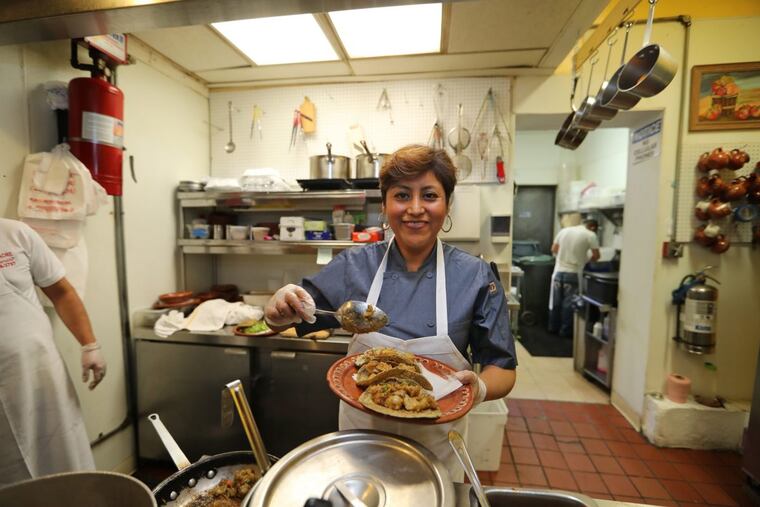El Compadre highlights the richness of our immigrant city
El Compadre is among Craig LaBan's best of Philadelphia.

On a chilly weekend morning last year, I spooned into a lamb consommé made by Cristina Martínez, felt my body defrost, and pondered the meaning of life in our immigrant city.
It's such a seemingly simple bowl of soup, this rustic brown broth with red chilies floating on top and a spoonful of rice and garbanzo beans at the bottom. And yet, there is something so truly satisfying in its soulful brew. The swelling resonance of chilies. The weedy, wild herb twang of epazote. The earthy essence of drippings from whole lambs steamed 10 hours inside spiky maguey leaves.
This is a bowl of Mexico true to the tradition chef Cristina Martínez (a.k.a. "La Patrona") inherited from her family of barbacoa masters in the mountain town of Capulhuac. Her legions of local fans came to love it first at the food cart she ran with her husband and partner, Benjamin Miller, then at the storefront called South Philly Barbacoa they ran on 11th Street. Now in a new space on Ninth Street in the Italian Market called El Compadre, which they decamped to earlier this year, neither that soup nor the ethereal lamb tacos that are also an essential part of a weekend meal here have lost an ounce of their spirit-warming magic.
But it's a genuine bowl of South Philly now, too, considering the stunning growth of our Mexican community in the last 15 years. Those immigrants — many undocumented, like Martínez — have greatly fueled the labor behind our mainstream restaurant boom, an emotional issue she and Miller have tackled with bold public activism.
But beyond the politics, they have made a meaningful mark on the city with their food. There are other wonderful places with more expansive menus — the excellent Blue Corn, Mole Poblano, El Jarrocho, Que Chula Es Puebla, and elegant pioneer Tequila's — among my favorites. But there's a special handcrafted power in Barbacoa's narrow focus.
Thwack! Thwack! Thwack!
Martínez's cleaver swings down behind a glass shield at a counter, hacking lamb parts into tacos on warm tortillas made from masa the restaurant itself nixtamalizes and grinds. Much of the corn is grown for them in Lancaster County from a variety of types, including a Zapatista corn indigenous to Mexico.
Cooked "blanca"-style, the lamb meat is pristinely plain and tender, all the better to embrace vibrant toppings, like the salsa of toasted pumpkin seeds and chipotle, or the tangy snap of cactus salad. Even tastier is the pancita, a chili-flecked pork sausage blended with fine-ground lamb offal that is the best heart, liver, kidney, and testicle taco you'll ever eat.
Most of the faithful (now equal parts Mexican and American) who wait in long lines at the counter already know the drill from its early days. The move to their equally small space at El Compadre has not lessened the waits, though a bonus during warmer weather is the availability of sidewalk seating.
Another bonus: Unlike their previous location, which was only open weekends for lamb, El Compadre operates from early morning through afternoon six days a week (closed Monday). And while the weekday menu doesn't include barbacoa, except when wrapped inside wonderfully crisp taquitos tubes, it allows Martínez and Miller to show their range as chefs, from the exceptional torta sandwiches served on house-baked rolls (try the pork meatballs in green salsa, or chicken in mole) to daily "guisados" that showcase homey dishes you won't find anywhere else.
Some tacos with giant shrimp in guajillo salsa were memorable. But so was the steak in creamy sauce with mushrooms, a sort of Mexicanized beef Stroganoff. Hard-core adventure eaters will covet the occasional pozole with chicken feet.
The move, however, came with a somber note. El Compadre had been run by Martínez's son until his untimely death early this year — an event the chef says still brings her though a daily roller-coaster of emotions.
The power of her work here, though, has only grown, both in the food and her work on behalf of undocumented immigrants' rights. A seven-part "radio novella" on Martínez's life, Mejor Vete, Cristina, was just released as a podcast by Univision.
Inside this cheery yellow room decorated with Mexican art, meanwhile, there is pure barbacoa joy at the floral cloth-draped community tables when friendly servers arrive with feasts of lamb measured by the kilo, wicker baskets full of freshly pressed hot tortillas, and refreshing cups of watermelon agua fresca. On colder days, terra cotta mugs of sweet masa atole is my preferred drink.
True to barbacoa tradition, the restaurant opens very early — as early as 5 a.m. on Saturdays to serve the workers getting off night shifts who built Martínez and Miller's business to begin with. By early afternoon, the lamb is usually gone. But there's almost always still some consommé.
Take a spoonful, let it warm your soul, and register this truth: Our immigrant city is far richer now for it than ever before.